Professional Development | Self-Analysis as a Supervisor
VerifiedAdded on 2022/09/09
|17
|3737
|18
AI Summary
Contribute Materials
Your contribution can guide someone’s learning journey. Share your
documents today.
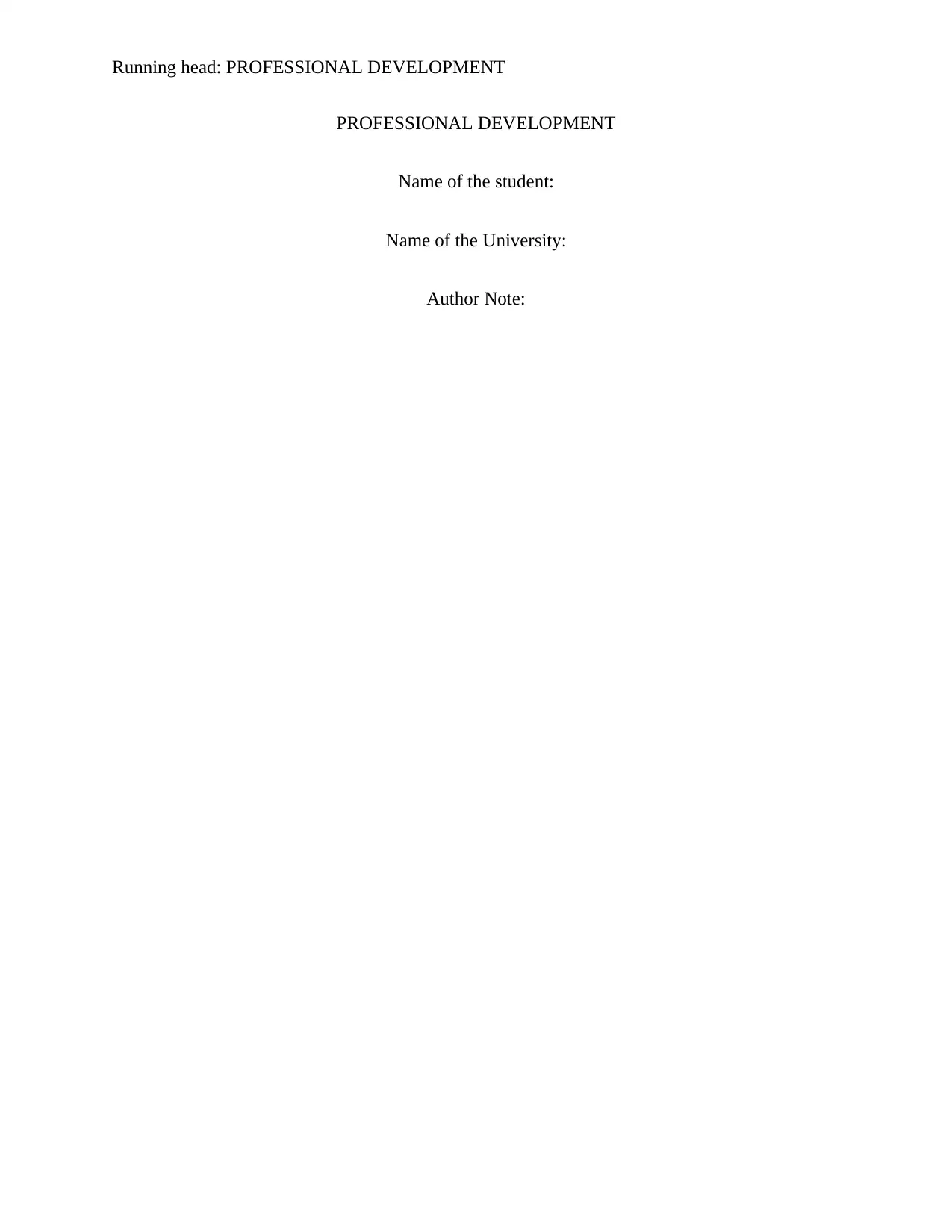
Running head: PROFESSIONAL DEVELOPMENT
PROFESSIONAL DEVELOPMENT
Name of the student:
Name of the University:
Author Note:
PROFESSIONAL DEVELOPMENT
Name of the student:
Name of the University:
Author Note:
Secure Best Marks with AI Grader
Need help grading? Try our AI Grader for instant feedback on your assignments.
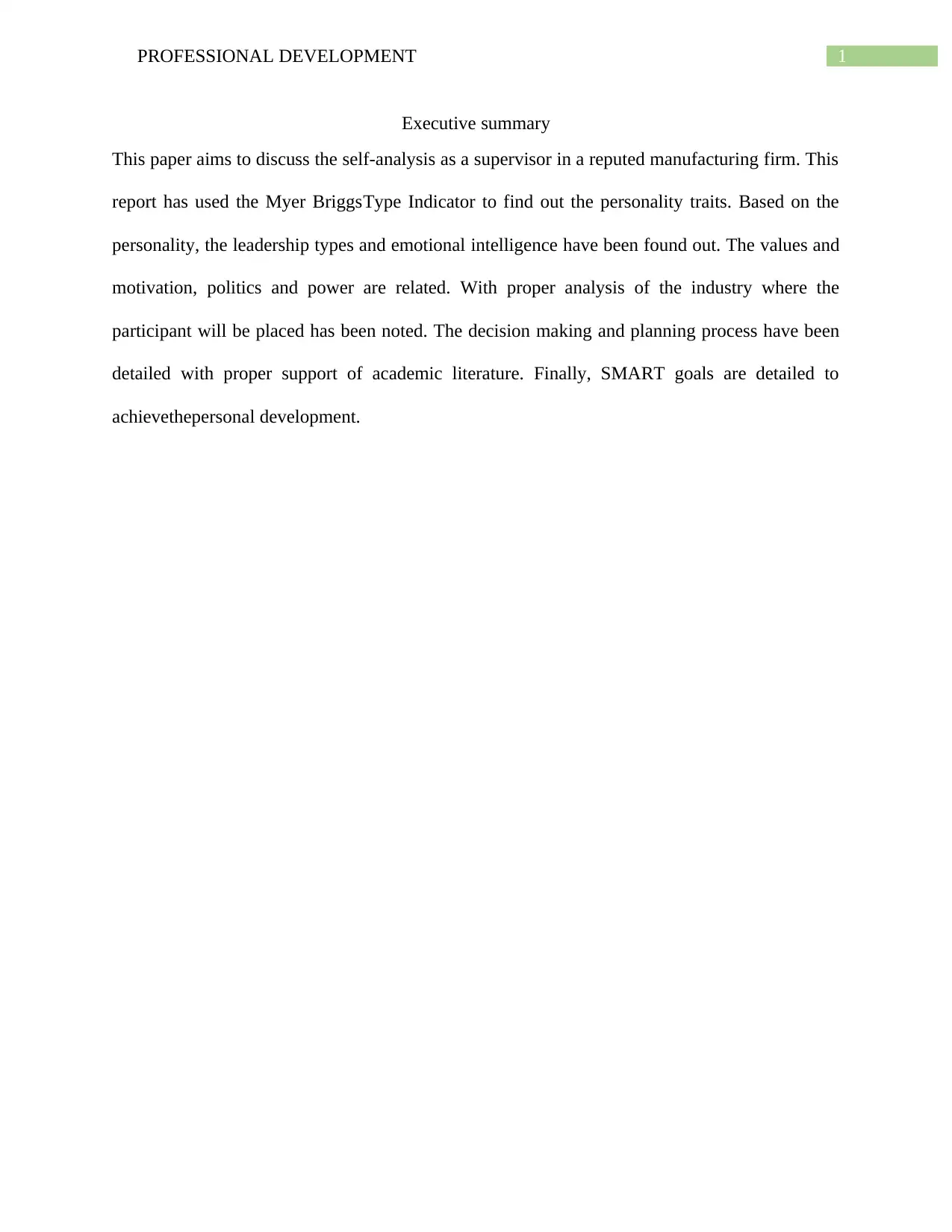
1PROFESSIONAL DEVELOPMENT
Executive summary
This paper aims to discuss the self-analysis as a supervisor in a reputed manufacturing firm. This
report has used the Myer BriggsType Indicator to find out the personality traits. Based on the
personality, the leadership types and emotional intelligence have been found out. The values and
motivation, politics and power are related. With proper analysis of the industry where the
participant will be placed has been noted. The decision making and planning process have been
detailed with proper support of academic literature. Finally, SMART goals are detailed to
achievethepersonal development.
Executive summary
This paper aims to discuss the self-analysis as a supervisor in a reputed manufacturing firm. This
report has used the Myer BriggsType Indicator to find out the personality traits. Based on the
personality, the leadership types and emotional intelligence have been found out. The values and
motivation, politics and power are related. With proper analysis of the industry where the
participant will be placed has been noted. The decision making and planning process have been
detailed with proper support of academic literature. Finally, SMART goals are detailed to
achievethepersonal development.
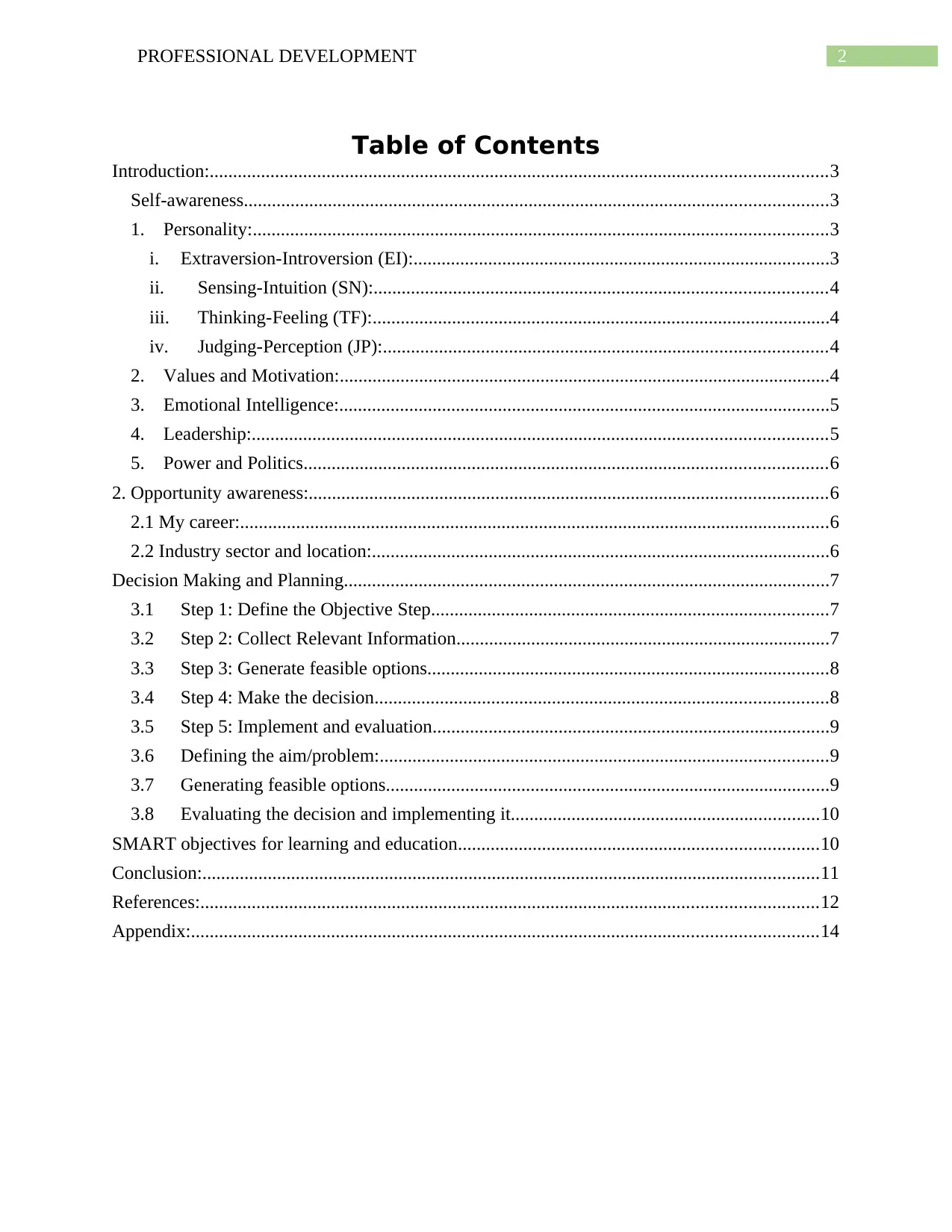
2PROFESSIONAL DEVELOPMENT
Table of Contents
Introduction:....................................................................................................................................3
Self-awareness.............................................................................................................................3
1. Personality:...........................................................................................................................3
i. Extraversion-Introversion (EI):.........................................................................................3
ii. Sensing-Intuition (SN):.................................................................................................4
iii. Thinking-Feeling (TF):..................................................................................................4
iv. Judging-Perception (JP):...............................................................................................4
2. Values and Motivation:.........................................................................................................4
3. Emotional Intelligence:.........................................................................................................5
4. Leadership:...........................................................................................................................5
5. Power and Politics................................................................................................................6
2. Opportunity awareness:...............................................................................................................6
2.1 My career:..............................................................................................................................6
2.2 Industry sector and location:..................................................................................................6
Decision Making and Planning........................................................................................................7
3.1 Step 1: Define the Objective Step.....................................................................................7
3.2 Step 2: Collect Relevant Information................................................................................7
3.3 Step 3: Generate feasible options......................................................................................8
3.4 Step 4: Make the decision.................................................................................................8
3.5 Step 5: Implement and evaluation.....................................................................................9
3.6 Defining the aim/problem:................................................................................................9
3.7 Generating feasible options...............................................................................................9
3.8 Evaluating the decision and implementing it..................................................................10
SMART objectives for learning and education.............................................................................10
Conclusion:....................................................................................................................................11
References:....................................................................................................................................12
Appendix:......................................................................................................................................14
Table of Contents
Introduction:....................................................................................................................................3
Self-awareness.............................................................................................................................3
1. Personality:...........................................................................................................................3
i. Extraversion-Introversion (EI):.........................................................................................3
ii. Sensing-Intuition (SN):.................................................................................................4
iii. Thinking-Feeling (TF):..................................................................................................4
iv. Judging-Perception (JP):...............................................................................................4
2. Values and Motivation:.........................................................................................................4
3. Emotional Intelligence:.........................................................................................................5
4. Leadership:...........................................................................................................................5
5. Power and Politics................................................................................................................6
2. Opportunity awareness:...............................................................................................................6
2.1 My career:..............................................................................................................................6
2.2 Industry sector and location:..................................................................................................6
Decision Making and Planning........................................................................................................7
3.1 Step 1: Define the Objective Step.....................................................................................7
3.2 Step 2: Collect Relevant Information................................................................................7
3.3 Step 3: Generate feasible options......................................................................................8
3.4 Step 4: Make the decision.................................................................................................8
3.5 Step 5: Implement and evaluation.....................................................................................9
3.6 Defining the aim/problem:................................................................................................9
3.7 Generating feasible options...............................................................................................9
3.8 Evaluating the decision and implementing it..................................................................10
SMART objectives for learning and education.............................................................................10
Conclusion:....................................................................................................................................11
References:....................................................................................................................................12
Appendix:......................................................................................................................................14
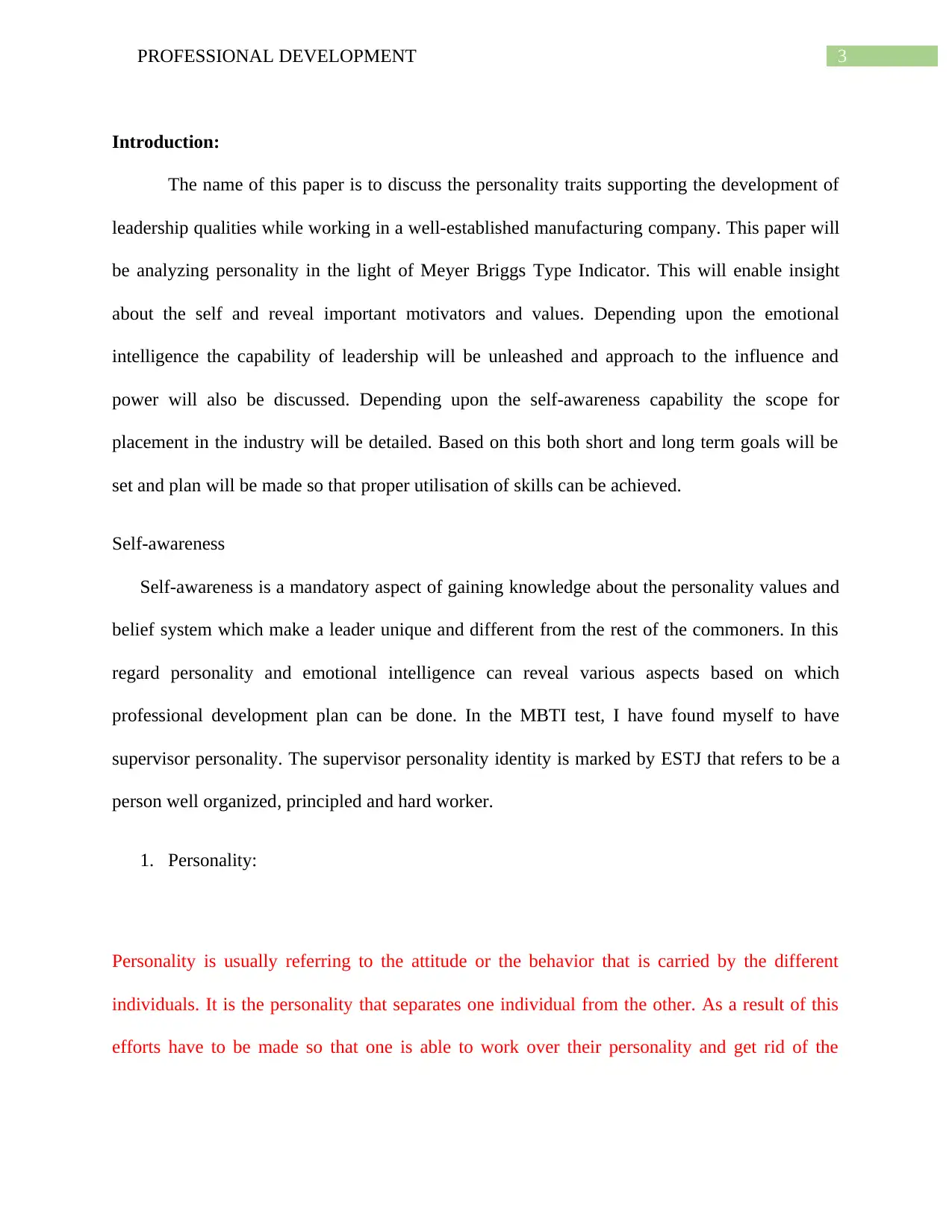
3PROFESSIONAL DEVELOPMENT
Introduction:
The name of this paper is to discuss the personality traits supporting the development of
leadership qualities while working in a well-established manufacturing company. This paper will
be analyzing personality in the light of Meyer Briggs Type Indicator. This will enable insight
about the self and reveal important motivators and values. Depending upon the emotional
intelligence the capability of leadership will be unleashed and approach to the influence and
power will also be discussed. Depending upon the self-awareness capability the scope for
placement in the industry will be detailed. Based on this both short and long term goals will be
set and plan will be made so that proper utilisation of skills can be achieved.
Self-awareness
Self-awareness is a mandatory aspect of gaining knowledge about the personality values and
belief system which make a leader unique and different from the rest of the commoners. In this
regard personality and emotional intelligence can reveal various aspects based on which
professional development plan can be done. In the MBTI test, I have found myself to have
supervisor personality. The supervisor personality identity is marked by ESTJ that refers to be a
person well organized, principled and hard worker.
1. Personality:
Personality is usually referring to the attitude or the behavior that is carried by the different
individuals. It is the personality that separates one individual from the other. As a result of this
efforts have to be made so that one is able to work over their personality and get rid of the
Introduction:
The name of this paper is to discuss the personality traits supporting the development of
leadership qualities while working in a well-established manufacturing company. This paper will
be analyzing personality in the light of Meyer Briggs Type Indicator. This will enable insight
about the self and reveal important motivators and values. Depending upon the emotional
intelligence the capability of leadership will be unleashed and approach to the influence and
power will also be discussed. Depending upon the self-awareness capability the scope for
placement in the industry will be detailed. Based on this both short and long term goals will be
set and plan will be made so that proper utilisation of skills can be achieved.
Self-awareness
Self-awareness is a mandatory aspect of gaining knowledge about the personality values and
belief system which make a leader unique and different from the rest of the commoners. In this
regard personality and emotional intelligence can reveal various aspects based on which
professional development plan can be done. In the MBTI test, I have found myself to have
supervisor personality. The supervisor personality identity is marked by ESTJ that refers to be a
person well organized, principled and hard worker.
1. Personality:
Personality is usually referring to the attitude or the behavior that is carried by the different
individuals. It is the personality that separates one individual from the other. As a result of this
efforts have to be made so that one is able to work over their personality and get rid of the
Secure Best Marks with AI Grader
Need help grading? Try our AI Grader for instant feedback on your assignments.
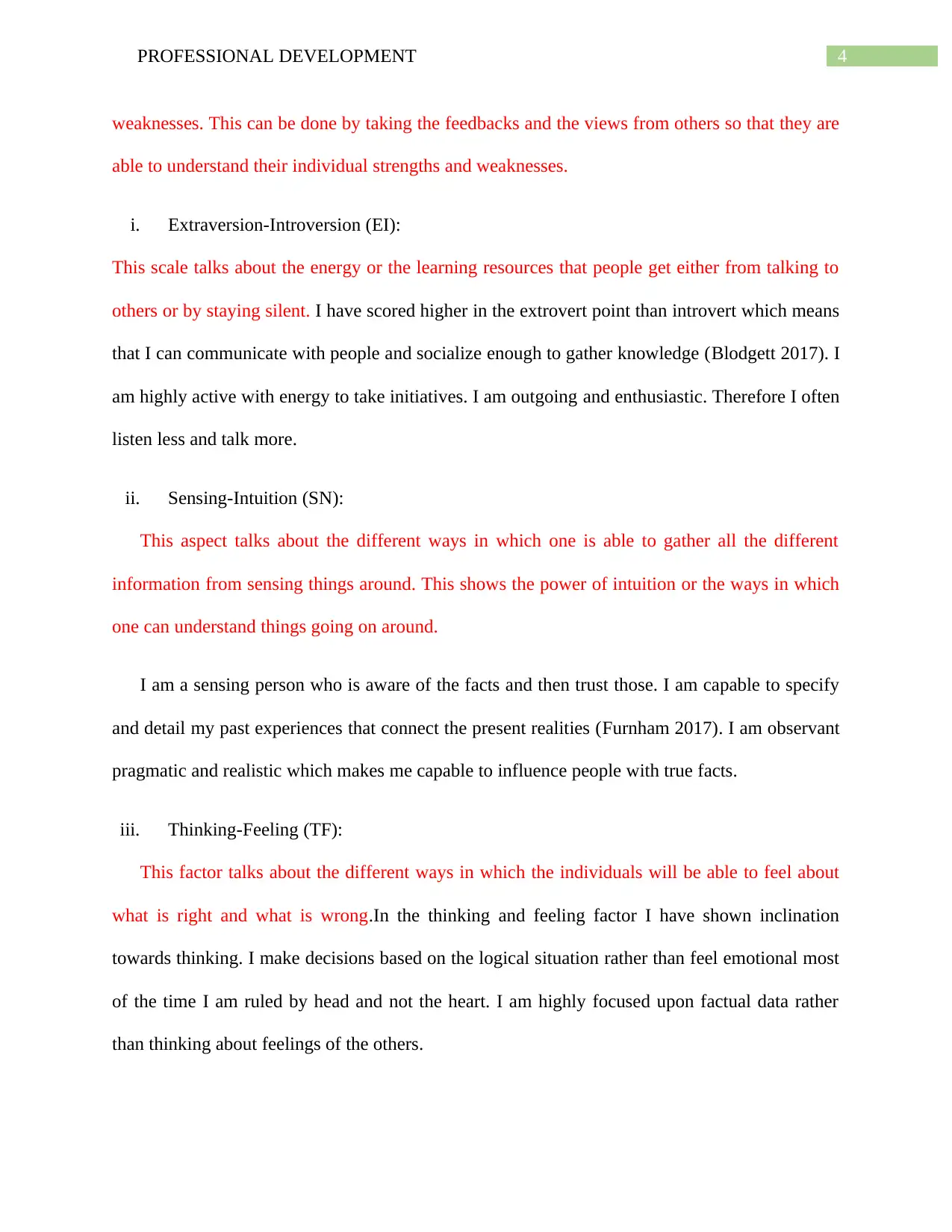
4PROFESSIONAL DEVELOPMENT
weaknesses. This can be done by taking the feedbacks and the views from others so that they are
able to understand their individual strengths and weaknesses.
i. Extraversion-Introversion (EI):
This scale talks about the energy or the learning resources that people get either from talking to
others or by staying silent. I have scored higher in the extrovert point than introvert which means
that I can communicate with people and socialize enough to gather knowledge (Blodgett 2017). I
am highly active with energy to take initiatives. I am outgoing and enthusiastic. Therefore I often
listen less and talk more.
ii. Sensing-Intuition (SN):
This aspect talks about the different ways in which one is able to gather all the different
information from sensing things around. This shows the power of intuition or the ways in which
one can understand things going on around.
I am a sensing person who is aware of the facts and then trust those. I am capable to specify
and detail my past experiences that connect the present realities (Furnham 2017). I am observant
pragmatic and realistic which makes me capable to influence people with true facts.
iii. Thinking-Feeling (TF):
This factor talks about the different ways in which the individuals will be able to feel about
what is right and what is wrong.In the thinking and feeling factor I have shown inclination
towards thinking. I make decisions based on the logical situation rather than feel emotional most
of the time I am ruled by head and not the heart. I am highly focused upon factual data rather
than thinking about feelings of the others.
weaknesses. This can be done by taking the feedbacks and the views from others so that they are
able to understand their individual strengths and weaknesses.
i. Extraversion-Introversion (EI):
This scale talks about the energy or the learning resources that people get either from talking to
others or by staying silent. I have scored higher in the extrovert point than introvert which means
that I can communicate with people and socialize enough to gather knowledge (Blodgett 2017). I
am highly active with energy to take initiatives. I am outgoing and enthusiastic. Therefore I often
listen less and talk more.
ii. Sensing-Intuition (SN):
This aspect talks about the different ways in which one is able to gather all the different
information from sensing things around. This shows the power of intuition or the ways in which
one can understand things going on around.
I am a sensing person who is aware of the facts and then trust those. I am capable to specify
and detail my past experiences that connect the present realities (Furnham 2017). I am observant
pragmatic and realistic which makes me capable to influence people with true facts.
iii. Thinking-Feeling (TF):
This factor talks about the different ways in which the individuals will be able to feel about
what is right and what is wrong.In the thinking and feeling factor I have shown inclination
towards thinking. I make decisions based on the logical situation rather than feel emotional most
of the time I am ruled by head and not the heart. I am highly focused upon factual data rather
than thinking about feelings of the others.
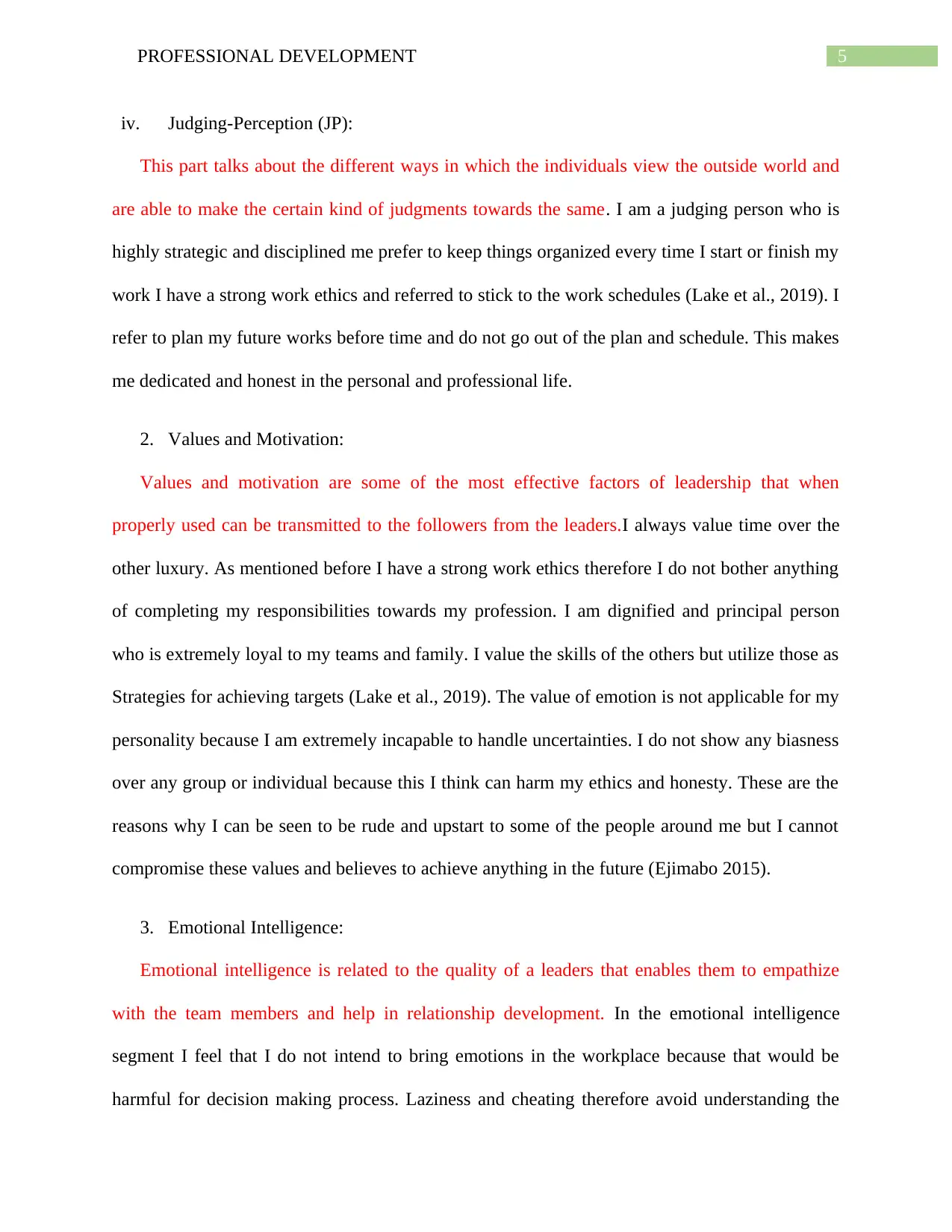
5PROFESSIONAL DEVELOPMENT
iv. Judging-Perception (JP):
This part talks about the different ways in which the individuals view the outside world and
are able to make the certain kind of judgments towards the same. I am a judging person who is
highly strategic and disciplined me prefer to keep things organized every time I start or finish my
work I have a strong work ethics and referred to stick to the work schedules (Lake et al., 2019). I
refer to plan my future works before time and do not go out of the plan and schedule. This makes
me dedicated and honest in the personal and professional life.
2. Values and Motivation:
Values and motivation are some of the most effective factors of leadership that when
properly used can be transmitted to the followers from the leaders.I always value time over the
other luxury. As mentioned before I have a strong work ethics therefore I do not bother anything
of completing my responsibilities towards my profession. I am dignified and principal person
who is extremely loyal to my teams and family. I value the skills of the others but utilize those as
Strategies for achieving targets (Lake et al., 2019). The value of emotion is not applicable for my
personality because I am extremely incapable to handle uncertainties. I do not show any biasness
over any group or individual because this I think can harm my ethics and honesty. These are the
reasons why I can be seen to be rude and upstart to some of the people around me but I cannot
compromise these values and believes to achieve anything in the future (Ejimabo 2015).
3. Emotional Intelligence:
Emotional intelligence is related to the quality of a leaders that enables them to empathize
with the team members and help in relationship development. In the emotional intelligence
segment I feel that I do not intend to bring emotions in the workplace because that would be
harmful for decision making process. Laziness and cheating therefore avoid understanding the
iv. Judging-Perception (JP):
This part talks about the different ways in which the individuals view the outside world and
are able to make the certain kind of judgments towards the same. I am a judging person who is
highly strategic and disciplined me prefer to keep things organized every time I start or finish my
work I have a strong work ethics and referred to stick to the work schedules (Lake et al., 2019). I
refer to plan my future works before time and do not go out of the plan and schedule. This makes
me dedicated and honest in the personal and professional life.
2. Values and Motivation:
Values and motivation are some of the most effective factors of leadership that when
properly used can be transmitted to the followers from the leaders.I always value time over the
other luxury. As mentioned before I have a strong work ethics therefore I do not bother anything
of completing my responsibilities towards my profession. I am dignified and principal person
who is extremely loyal to my teams and family. I value the skills of the others but utilize those as
Strategies for achieving targets (Lake et al., 2019). The value of emotion is not applicable for my
personality because I am extremely incapable to handle uncertainties. I do not show any biasness
over any group or individual because this I think can harm my ethics and honesty. These are the
reasons why I can be seen to be rude and upstart to some of the people around me but I cannot
compromise these values and believes to achieve anything in the future (Ejimabo 2015).
3. Emotional Intelligence:
Emotional intelligence is related to the quality of a leaders that enables them to empathize
with the team members and help in relationship development. In the emotional intelligence
segment I feel that I do not intend to bring emotions in the workplace because that would be
harmful for decision making process. Laziness and cheating therefore avoid understanding the
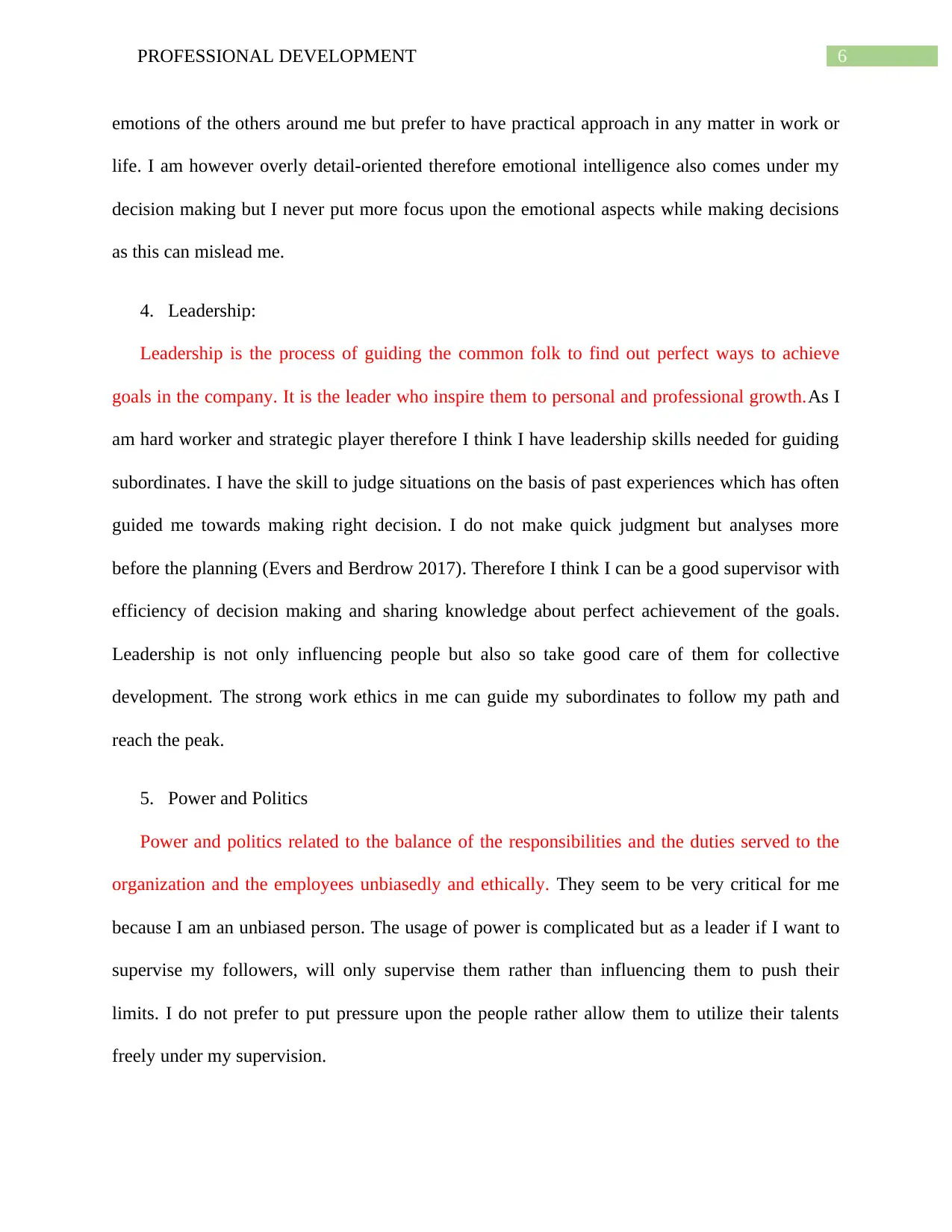
6PROFESSIONAL DEVELOPMENT
emotions of the others around me but prefer to have practical approach in any matter in work or
life. I am however overly detail-oriented therefore emotional intelligence also comes under my
decision making but I never put more focus upon the emotional aspects while making decisions
as this can mislead me.
4. Leadership:
Leadership is the process of guiding the common folk to find out perfect ways to achieve
goals in the company. It is the leader who inspire them to personal and professional growth.As I
am hard worker and strategic player therefore I think I have leadership skills needed for guiding
subordinates. I have the skill to judge situations on the basis of past experiences which has often
guided me towards making right decision. I do not make quick judgment but analyses more
before the planning (Evers and Berdrow 2017). Therefore I think I can be a good supervisor with
efficiency of decision making and sharing knowledge about perfect achievement of the goals.
Leadership is not only influencing people but also so take good care of them for collective
development. The strong work ethics in me can guide my subordinates to follow my path and
reach the peak.
5. Power and Politics
Power and politics related to the balance of the responsibilities and the duties served to the
organization and the employees unbiasedly and ethically. They seem to be very critical for me
because I am an unbiased person. The usage of power is complicated but as a leader if I want to
supervise my followers, will only supervise them rather than influencing them to push their
limits. I do not prefer to put pressure upon the people rather allow them to utilize their talents
freely under my supervision.
emotions of the others around me but prefer to have practical approach in any matter in work or
life. I am however overly detail-oriented therefore emotional intelligence also comes under my
decision making but I never put more focus upon the emotional aspects while making decisions
as this can mislead me.
4. Leadership:
Leadership is the process of guiding the common folk to find out perfect ways to achieve
goals in the company. It is the leader who inspire them to personal and professional growth.As I
am hard worker and strategic player therefore I think I have leadership skills needed for guiding
subordinates. I have the skill to judge situations on the basis of past experiences which has often
guided me towards making right decision. I do not make quick judgment but analyses more
before the planning (Evers and Berdrow 2017). Therefore I think I can be a good supervisor with
efficiency of decision making and sharing knowledge about perfect achievement of the goals.
Leadership is not only influencing people but also so take good care of them for collective
development. The strong work ethics in me can guide my subordinates to follow my path and
reach the peak.
5. Power and Politics
Power and politics related to the balance of the responsibilities and the duties served to the
organization and the employees unbiasedly and ethically. They seem to be very critical for me
because I am an unbiased person. The usage of power is complicated but as a leader if I want to
supervise my followers, will only supervise them rather than influencing them to push their
limits. I do not prefer to put pressure upon the people rather allow them to utilize their talents
freely under my supervision.
Paraphrase This Document
Need a fresh take? Get an instant paraphrase of this document with our AI Paraphraser
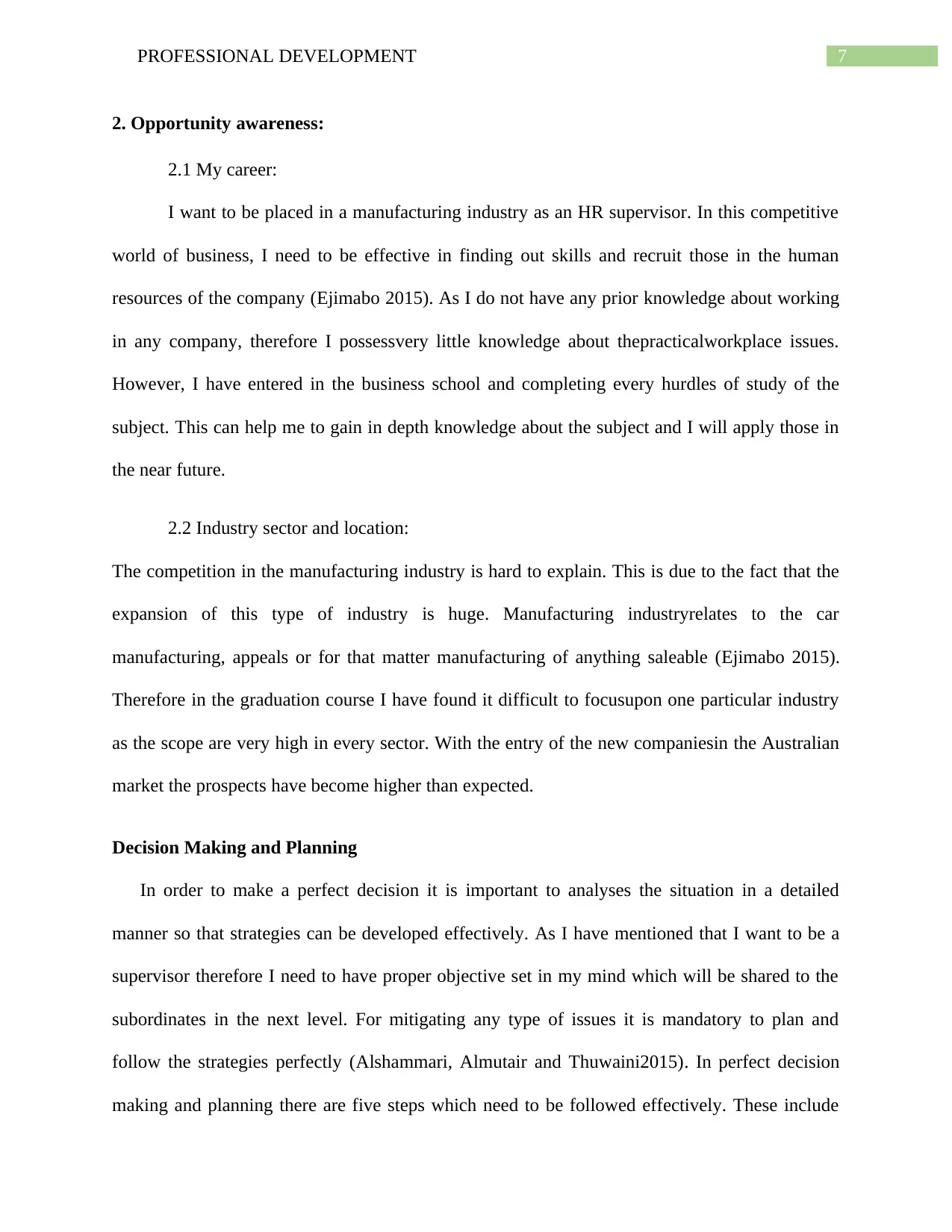
7PROFESSIONAL DEVELOPMENT
2. Opportunity awareness:
2.1 My career:
I want to be placed in a manufacturing industry as an HR supervisor. In this competitive
world of business, I need to be effective in finding out skills and recruit those in the human
resources of the company (Ejimabo 2015). As I do not have any prior knowledge about working
in any company, therefore I possessvery little knowledge about thepracticalworkplace issues.
However, I have entered in the business school and completing every hurdles of study of the
subject. This can help me to gain in depth knowledge about the subject and I will apply those in
the near future.
2.2 Industry sector and location:
The competition in the manufacturing industry is hard to explain. This is due to the fact that the
expansion of this type of industry is huge. Manufacturing industryrelates to the car
manufacturing, appeals or for that matter manufacturing of anything saleable (Ejimabo 2015).
Therefore in the graduation course I have found it difficult to focusupon one particular industry
as the scope are very high in every sector. With the entry of the new companiesin the Australian
market the prospects have become higher than expected.
Decision Making and Planning
In order to make a perfect decision it is important to analyses the situation in a detailed
manner so that strategies can be developed effectively. As I have mentioned that I want to be a
supervisor therefore I need to have proper objective set in my mind which will be shared to the
subordinates in the next level. For mitigating any type of issues it is mandatory to plan and
follow the strategies perfectly (Alshammari, Almutair and Thuwaini2015). In perfect decision
making and planning there are five steps which need to be followed effectively. These include
2. Opportunity awareness:
2.1 My career:
I want to be placed in a manufacturing industry as an HR supervisor. In this competitive
world of business, I need to be effective in finding out skills and recruit those in the human
resources of the company (Ejimabo 2015). As I do not have any prior knowledge about working
in any company, therefore I possessvery little knowledge about thepracticalworkplace issues.
However, I have entered in the business school and completing every hurdles of study of the
subject. This can help me to gain in depth knowledge about the subject and I will apply those in
the near future.
2.2 Industry sector and location:
The competition in the manufacturing industry is hard to explain. This is due to the fact that the
expansion of this type of industry is huge. Manufacturing industryrelates to the car
manufacturing, appeals or for that matter manufacturing of anything saleable (Ejimabo 2015).
Therefore in the graduation course I have found it difficult to focusupon one particular industry
as the scope are very high in every sector. With the entry of the new companiesin the Australian
market the prospects have become higher than expected.
Decision Making and Planning
In order to make a perfect decision it is important to analyses the situation in a detailed
manner so that strategies can be developed effectively. As I have mentioned that I want to be a
supervisor therefore I need to have proper objective set in my mind which will be shared to the
subordinates in the next level. For mitigating any type of issues it is mandatory to plan and
follow the strategies perfectly (Alshammari, Almutair and Thuwaini2015). In perfect decision
making and planning there are five steps which need to be followed effectively. These include
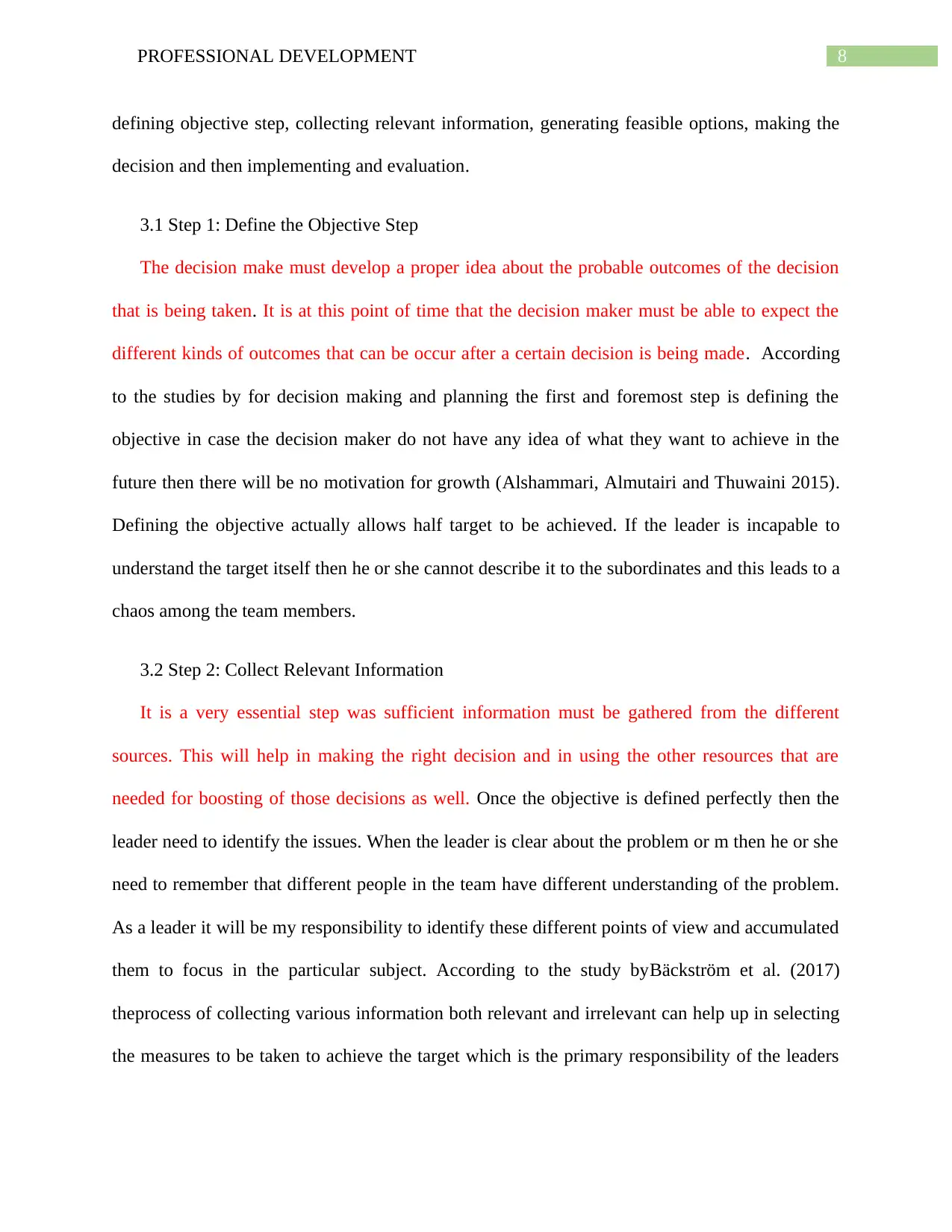
8PROFESSIONAL DEVELOPMENT
defining objective step, collecting relevant information, generating feasible options, making the
decision and then implementing and evaluation.
3.1 Step 1: Define the Objective Step
The decision make must develop a proper idea about the probable outcomes of the decision
that is being taken. It is at this point of time that the decision maker must be able to expect the
different kinds of outcomes that can be occur after a certain decision is being made. According
to the studies by for decision making and planning the first and foremost step is defining the
objective in case the decision maker do not have any idea of what they want to achieve in the
future then there will be no motivation for growth (Alshammari, Almutairi and Thuwaini 2015).
Defining the objective actually allows half target to be achieved. If the leader is incapable to
understand the target itself then he or she cannot describe it to the subordinates and this leads to a
chaos among the team members.
3.2 Step 2: Collect Relevant Information
It is a very essential step was sufficient information must be gathered from the different
sources. This will help in making the right decision and in using the other resources that are
needed for boosting of those decisions as well. Once the objective is defined perfectly then the
leader need to identify the issues. When the leader is clear about the problem or m then he or she
need to remember that different people in the team have different understanding of the problem.
As a leader it will be my responsibility to identify these different points of view and accumulated
them to focus in the particular subject. According to the study byBäckström et al. (2017)
theprocess of collecting various information both relevant and irrelevant can help up in selecting
the measures to be taken to achieve the target which is the primary responsibility of the leaders
defining objective step, collecting relevant information, generating feasible options, making the
decision and then implementing and evaluation.
3.1 Step 1: Define the Objective Step
The decision make must develop a proper idea about the probable outcomes of the decision
that is being taken. It is at this point of time that the decision maker must be able to expect the
different kinds of outcomes that can be occur after a certain decision is being made. According
to the studies by for decision making and planning the first and foremost step is defining the
objective in case the decision maker do not have any idea of what they want to achieve in the
future then there will be no motivation for growth (Alshammari, Almutairi and Thuwaini 2015).
Defining the objective actually allows half target to be achieved. If the leader is incapable to
understand the target itself then he or she cannot describe it to the subordinates and this leads to a
chaos among the team members.
3.2 Step 2: Collect Relevant Information
It is a very essential step was sufficient information must be gathered from the different
sources. This will help in making the right decision and in using the other resources that are
needed for boosting of those decisions as well. Once the objective is defined perfectly then the
leader need to identify the issues. When the leader is clear about the problem or m then he or she
need to remember that different people in the team have different understanding of the problem.
As a leader it will be my responsibility to identify these different points of view and accumulated
them to focus in the particular subject. According to the study byBäckström et al. (2017)
theprocess of collecting various information both relevant and irrelevant can help up in selecting
the measures to be taken to achieve the target which is the primary responsibility of the leaders
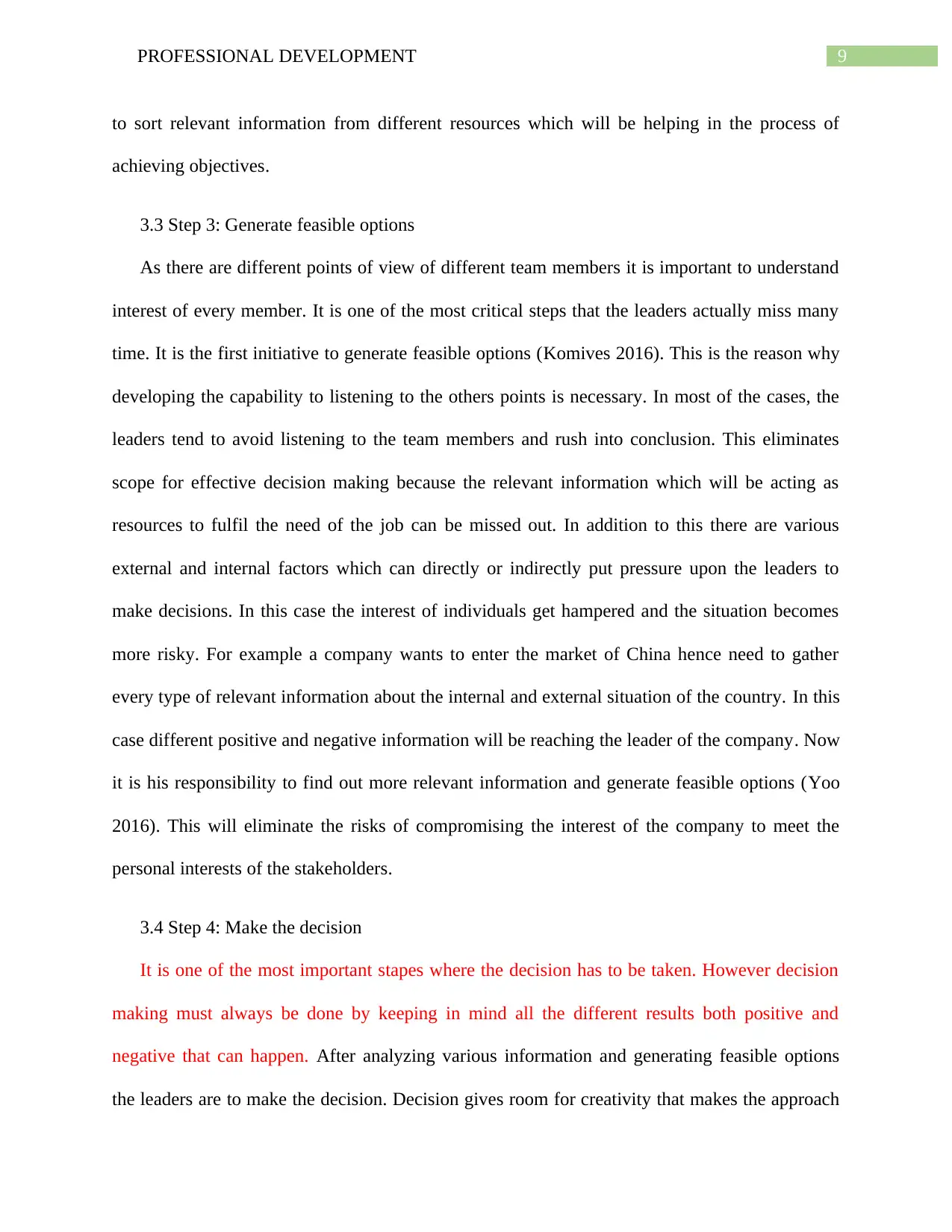
9PROFESSIONAL DEVELOPMENT
to sort relevant information from different resources which will be helping in the process of
achieving objectives.
3.3 Step 3: Generate feasible options
As there are different points of view of different team members it is important to understand
interest of every member. It is one of the most critical steps that the leaders actually miss many
time. It is the first initiative to generate feasible options (Komives 2016). This is the reason why
developing the capability to listening to the others points is necessary. In most of the cases, the
leaders tend to avoid listening to the team members and rush into conclusion. This eliminates
scope for effective decision making because the relevant information which will be acting as
resources to fulfil the need of the job can be missed out. In addition to this there are various
external and internal factors which can directly or indirectly put pressure upon the leaders to
make decisions. In this case the interest of individuals get hampered and the situation becomes
more risky. For example a company wants to enter the market of China hence need to gather
every type of relevant information about the internal and external situation of the country. In this
case different positive and negative information will be reaching the leader of the company. Now
it is his responsibility to find out more relevant information and generate feasible options (Yoo
2016). This will eliminate the risks of compromising the interest of the company to meet the
personal interests of the stakeholders.
3.4 Step 4: Make the decision
It is one of the most important stapes where the decision has to be taken. However decision
making must always be done by keeping in mind all the different results both positive and
negative that can happen. After analyzing various information and generating feasible options
the leaders are to make the decision. Decision gives room for creativity that makes the approach
to sort relevant information from different resources which will be helping in the process of
achieving objectives.
3.3 Step 3: Generate feasible options
As there are different points of view of different team members it is important to understand
interest of every member. It is one of the most critical steps that the leaders actually miss many
time. It is the first initiative to generate feasible options (Komives 2016). This is the reason why
developing the capability to listening to the others points is necessary. In most of the cases, the
leaders tend to avoid listening to the team members and rush into conclusion. This eliminates
scope for effective decision making because the relevant information which will be acting as
resources to fulfil the need of the job can be missed out. In addition to this there are various
external and internal factors which can directly or indirectly put pressure upon the leaders to
make decisions. In this case the interest of individuals get hampered and the situation becomes
more risky. For example a company wants to enter the market of China hence need to gather
every type of relevant information about the internal and external situation of the country. In this
case different positive and negative information will be reaching the leader of the company. Now
it is his responsibility to find out more relevant information and generate feasible options (Yoo
2016). This will eliminate the risks of compromising the interest of the company to meet the
personal interests of the stakeholders.
3.4 Step 4: Make the decision
It is one of the most important stapes where the decision has to be taken. However decision
making must always be done by keeping in mind all the different results both positive and
negative that can happen. After analyzing various information and generating feasible options
the leaders are to make the decision. Decision gives room for creativity that makes the approach
Secure Best Marks with AI Grader
Need help grading? Try our AI Grader for instant feedback on your assignments.
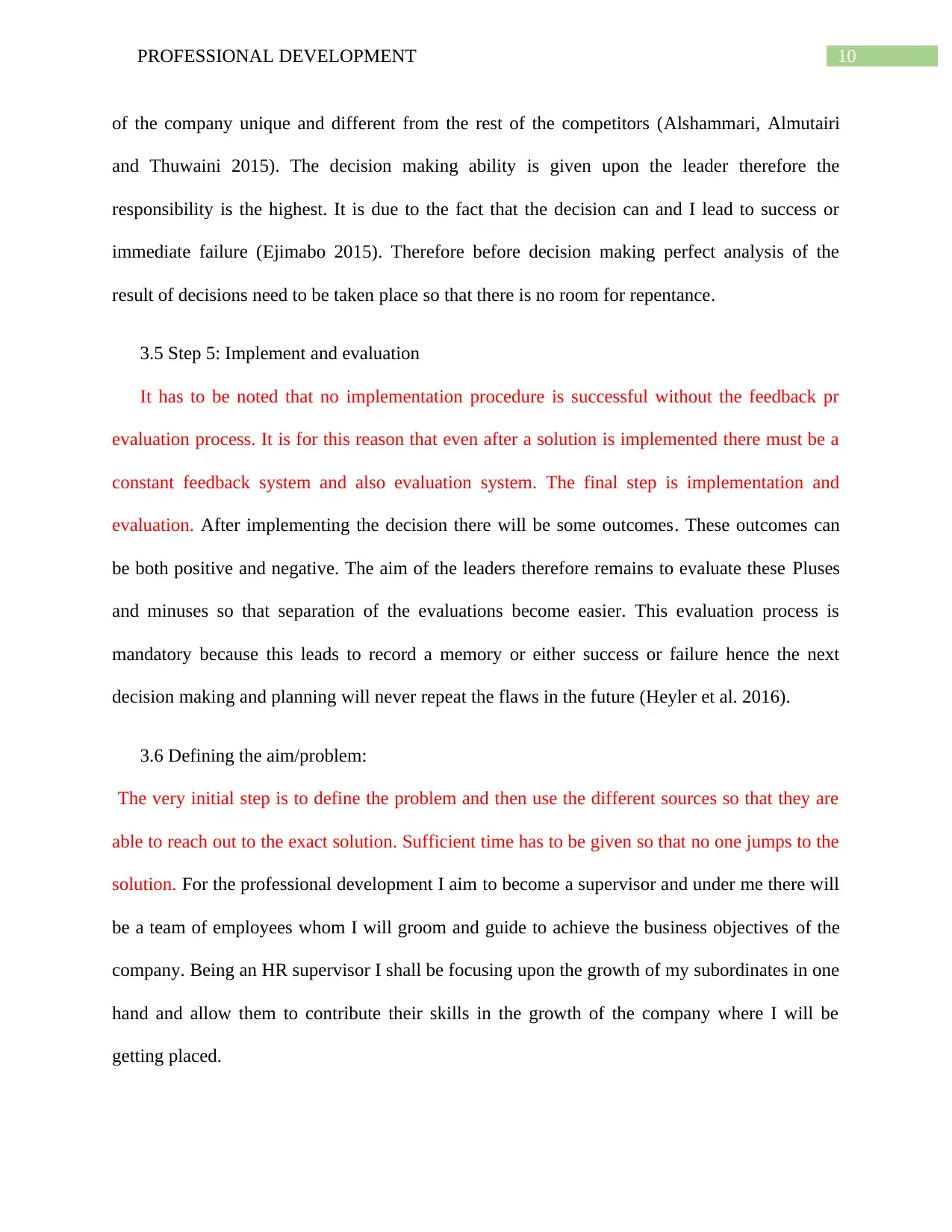
10PROFESSIONAL DEVELOPMENT
of the company unique and different from the rest of the competitors (Alshammari, Almutairi
and Thuwaini 2015). The decision making ability is given upon the leader therefore the
responsibility is the highest. It is due to the fact that the decision can and I lead to success or
immediate failure (Ejimabo 2015). Therefore before decision making perfect analysis of the
result of decisions need to be taken place so that there is no room for repentance.
3.5 Step 5: Implement and evaluation
It has to be noted that no implementation procedure is successful without the feedback pr
evaluation process. It is for this reason that even after a solution is implemented there must be a
constant feedback system and also evaluation system. The final step is implementation and
evaluation. After implementing the decision there will be some outcomes. These outcomes can
be both positive and negative. The aim of the leaders therefore remains to evaluate these Pluses
and minuses so that separation of the evaluations become easier. This evaluation process is
mandatory because this leads to record a memory or either success or failure hence the next
decision making and planning will never repeat the flaws in the future (Heyler et al. 2016).
3.6 Defining the aim/problem:
The very initial step is to define the problem and then use the different sources so that they are
able to reach out to the exact solution. Sufficient time has to be given so that no one jumps to the
solution. For the professional development I aim to become a supervisor and under me there will
be a team of employees whom I will groom and guide to achieve the business objectives of the
company. Being an HR supervisor I shall be focusing upon the growth of my subordinates in one
hand and allow them to contribute their skills in the growth of the company where I will be
getting placed.
of the company unique and different from the rest of the competitors (Alshammari, Almutairi
and Thuwaini 2015). The decision making ability is given upon the leader therefore the
responsibility is the highest. It is due to the fact that the decision can and I lead to success or
immediate failure (Ejimabo 2015). Therefore before decision making perfect analysis of the
result of decisions need to be taken place so that there is no room for repentance.
3.5 Step 5: Implement and evaluation
It has to be noted that no implementation procedure is successful without the feedback pr
evaluation process. It is for this reason that even after a solution is implemented there must be a
constant feedback system and also evaluation system. The final step is implementation and
evaluation. After implementing the decision there will be some outcomes. These outcomes can
be both positive and negative. The aim of the leaders therefore remains to evaluate these Pluses
and minuses so that separation of the evaluations become easier. This evaluation process is
mandatory because this leads to record a memory or either success or failure hence the next
decision making and planning will never repeat the flaws in the future (Heyler et al. 2016).
3.6 Defining the aim/problem:
The very initial step is to define the problem and then use the different sources so that they are
able to reach out to the exact solution. Sufficient time has to be given so that no one jumps to the
solution. For the professional development I aim to become a supervisor and under me there will
be a team of employees whom I will groom and guide to achieve the business objectives of the
company. Being an HR supervisor I shall be focusing upon the growth of my subordinates in one
hand and allow them to contribute their skills in the growth of the company where I will be
getting placed.
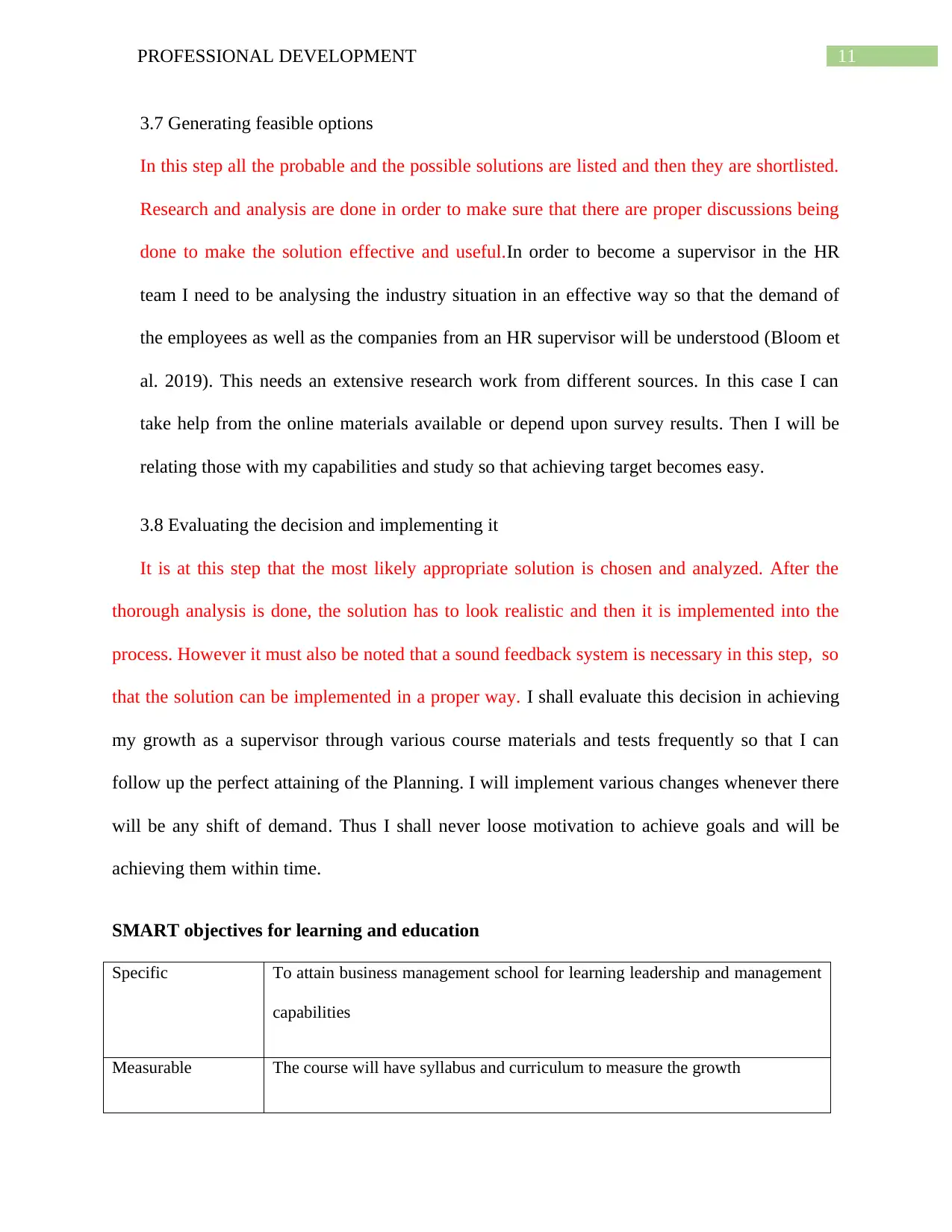
11PROFESSIONAL DEVELOPMENT
3.7 Generating feasible options
In this step all the probable and the possible solutions are listed and then they are shortlisted.
Research and analysis are done in order to make sure that there are proper discussions being
done to make the solution effective and useful.In order to become a supervisor in the HR
team I need to be analysing the industry situation in an effective way so that the demand of
the employees as well as the companies from an HR supervisor will be understood (Bloom et
al. 2019). This needs an extensive research work from different sources. In this case I can
take help from the online materials available or depend upon survey results. Then I will be
relating those with my capabilities and study so that achieving target becomes easy.
3.8 Evaluating the decision and implementing it
It is at this step that the most likely appropriate solution is chosen and analyzed. After the
thorough analysis is done, the solution has to look realistic and then it is implemented into the
process. However it must also be noted that a sound feedback system is necessary in this step, so
that the solution can be implemented in a proper way. I shall evaluate this decision in achieving
my growth as a supervisor through various course materials and tests frequently so that I can
follow up the perfect attaining of the Planning. I will implement various changes whenever there
will be any shift of demand. Thus I shall never loose motivation to achieve goals and will be
achieving them within time.
SMART objectives for learning and education
Specific To attain business management school for learning leadership and management
capabilities
Measurable The course will have syllabus and curriculum to measure the growth
3.7 Generating feasible options
In this step all the probable and the possible solutions are listed and then they are shortlisted.
Research and analysis are done in order to make sure that there are proper discussions being
done to make the solution effective and useful.In order to become a supervisor in the HR
team I need to be analysing the industry situation in an effective way so that the demand of
the employees as well as the companies from an HR supervisor will be understood (Bloom et
al. 2019). This needs an extensive research work from different sources. In this case I can
take help from the online materials available or depend upon survey results. Then I will be
relating those with my capabilities and study so that achieving target becomes easy.
3.8 Evaluating the decision and implementing it
It is at this step that the most likely appropriate solution is chosen and analyzed. After the
thorough analysis is done, the solution has to look realistic and then it is implemented into the
process. However it must also be noted that a sound feedback system is necessary in this step, so
that the solution can be implemented in a proper way. I shall evaluate this decision in achieving
my growth as a supervisor through various course materials and tests frequently so that I can
follow up the perfect attaining of the Planning. I will implement various changes whenever there
will be any shift of demand. Thus I shall never loose motivation to achieve goals and will be
achieving them within time.
SMART objectives for learning and education
Specific To attain business management school for learning leadership and management
capabilities
Measurable The course will have syllabus and curriculum to measure the growth
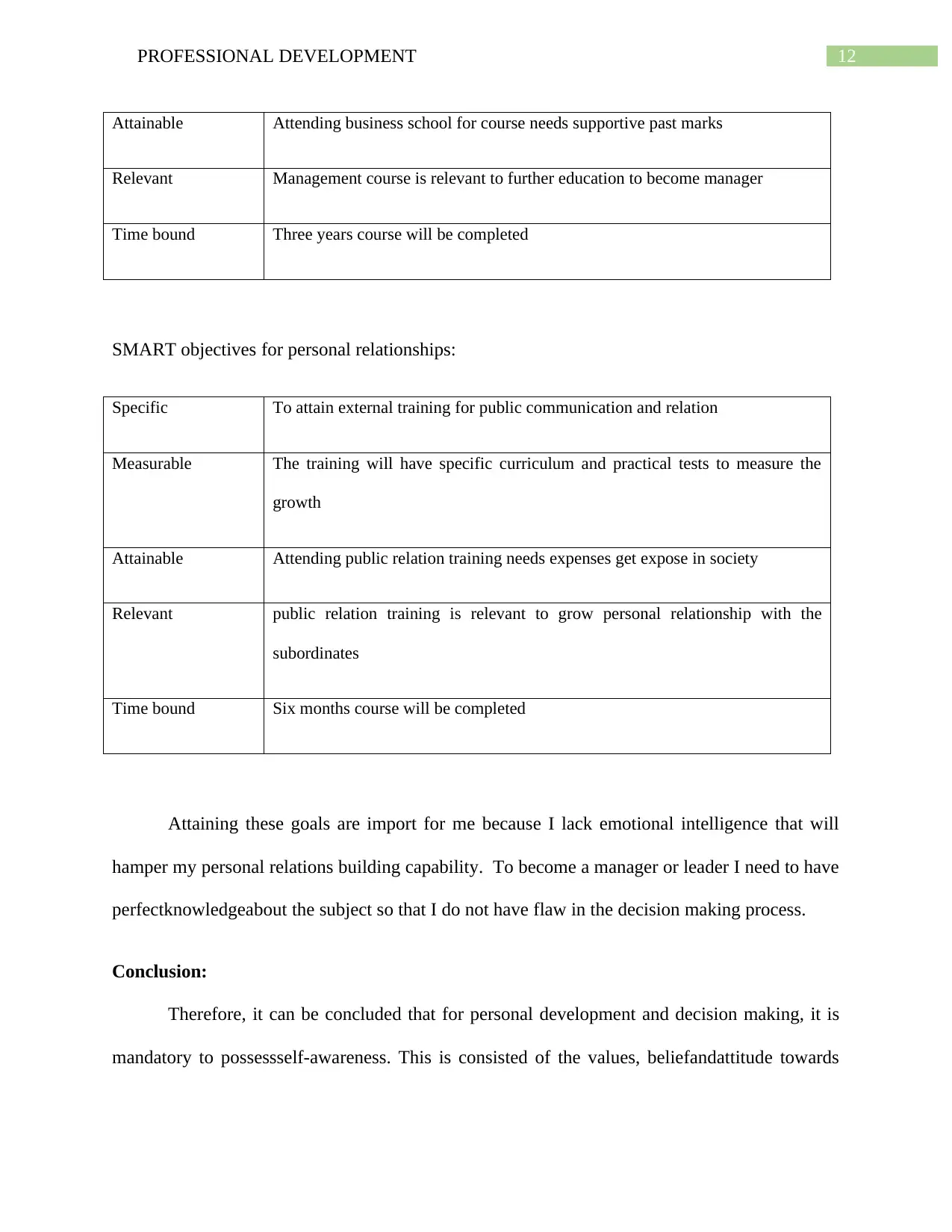
12PROFESSIONAL DEVELOPMENT
Attainable Attending business school for course needs supportive past marks
Relevant Management course is relevant to further education to become manager
Time bound Three years course will be completed
SMART objectives for personal relationships:
Specific To attain external training for public communication and relation
Measurable The training will have specific curriculum and practical tests to measure the
growth
Attainable Attending public relation training needs expenses get expose in society
Relevant public relation training is relevant to grow personal relationship with the
subordinates
Time bound Six months course will be completed
Attaining these goals are import for me because I lack emotional intelligence that will
hamper my personal relations building capability. To become a manager or leader I need to have
perfectknowledgeabout the subject so that I do not have flaw in the decision making process.
Conclusion:
Therefore, it can be concluded that for personal development and decision making, it is
mandatory to possessself-awareness. This is consisted of the values, beliefandattitude towards
Attainable Attending business school for course needs supportive past marks
Relevant Management course is relevant to further education to become manager
Time bound Three years course will be completed
SMART objectives for personal relationships:
Specific To attain external training for public communication and relation
Measurable The training will have specific curriculum and practical tests to measure the
growth
Attainable Attending public relation training needs expenses get expose in society
Relevant public relation training is relevant to grow personal relationship with the
subordinates
Time bound Six months course will be completed
Attaining these goals are import for me because I lack emotional intelligence that will
hamper my personal relations building capability. To become a manager or leader I need to have
perfectknowledgeabout the subject so that I do not have flaw in the decision making process.
Conclusion:
Therefore, it can be concluded that for personal development and decision making, it is
mandatory to possessself-awareness. This is consisted of the values, beliefandattitude towards
Paraphrase This Document
Need a fresh take? Get an instant paraphrase of this document with our AI Paraphraser
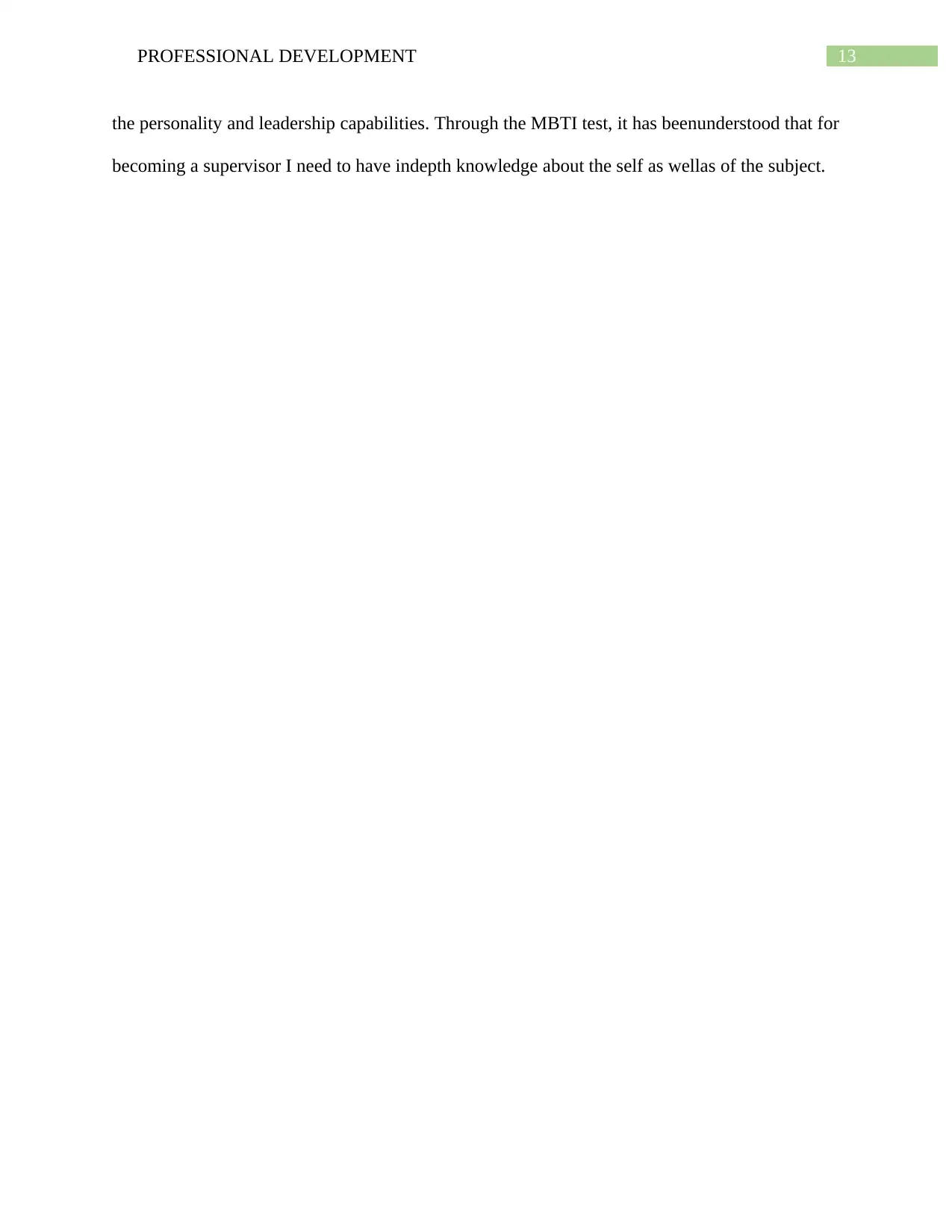
13PROFESSIONAL DEVELOPMENT
the personality and leadership capabilities. Through the MBTI test, it has beenunderstood that for
becoming a supervisor I need to have indepth knowledge about the self as wellas of the subject.
the personality and leadership capabilities. Through the MBTI test, it has beenunderstood that for
becoming a supervisor I need to have indepth knowledge about the self as wellas of the subject.
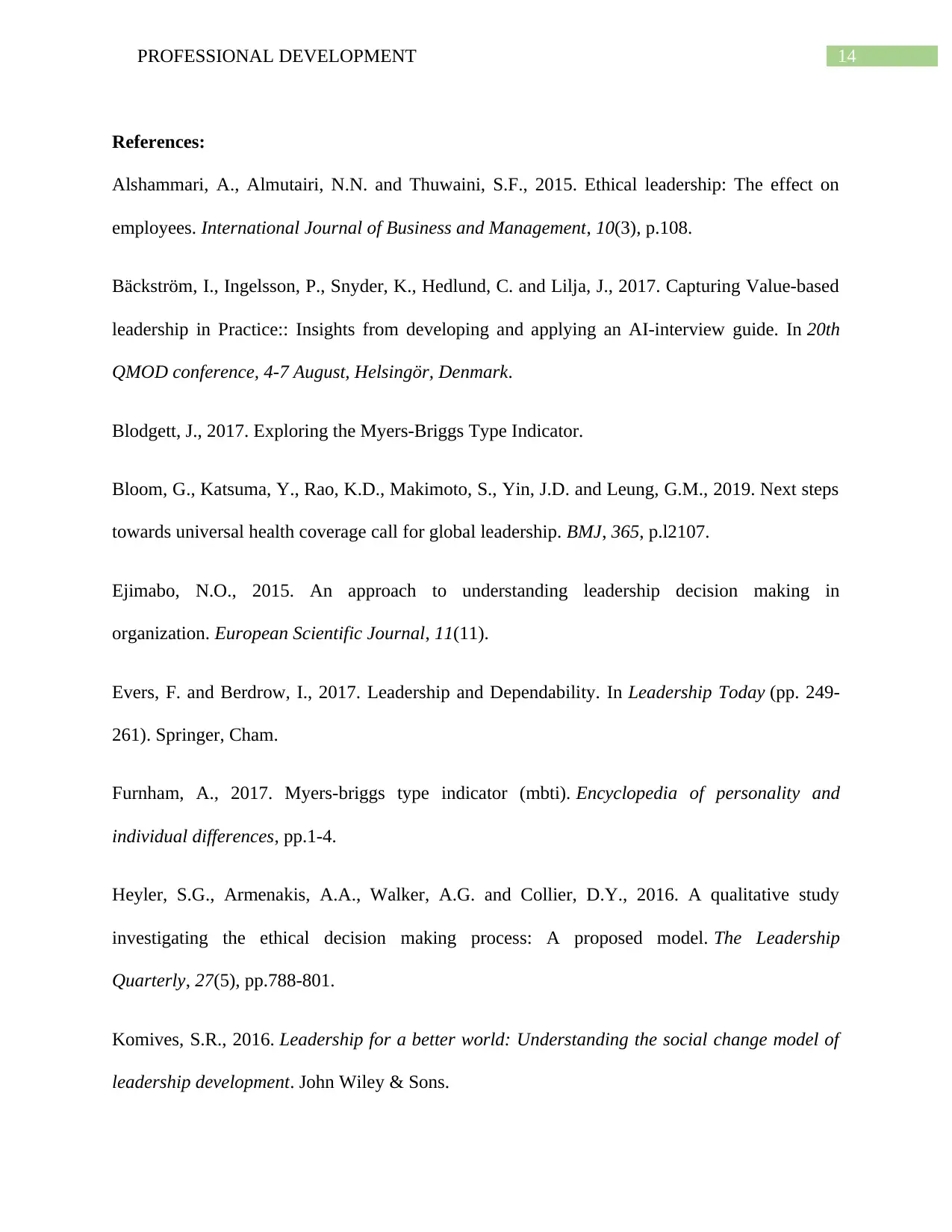
14PROFESSIONAL DEVELOPMENT
References:
Alshammari, A., Almutairi, N.N. and Thuwaini, S.F., 2015. Ethical leadership: The effect on
employees. International Journal of Business and Management, 10(3), p.108.
Bäckström, I., Ingelsson, P., Snyder, K., Hedlund, C. and Lilja, J., 2017. Capturing Value-based
leadership in Practice:: Insights from developing and applying an AI-interview guide. In 20th
QMOD conference, 4-7 August, Helsingör, Denmark.
Blodgett, J., 2017. Exploring the Myers-Briggs Type Indicator.
Bloom, G., Katsuma, Y., Rao, K.D., Makimoto, S., Yin, J.D. and Leung, G.M., 2019. Next steps
towards universal health coverage call for global leadership. BMJ, 365, p.l2107.
Ejimabo, N.O., 2015. An approach to understanding leadership decision making in
organization. European Scientific Journal, 11(11).
Evers, F. and Berdrow, I., 2017. Leadership and Dependability. In Leadership Today (pp. 249-
261). Springer, Cham.
Furnham, A., 2017. Myers-briggs type indicator (mbti). Encyclopedia of personality and
individual differences, pp.1-4.
Heyler, S.G., Armenakis, A.A., Walker, A.G. and Collier, D.Y., 2016. A qualitative study
investigating the ethical decision making process: A proposed model. The Leadership
Quarterly, 27(5), pp.788-801.
Komives, S.R., 2016. Leadership for a better world: Understanding the social change model of
leadership development. John Wiley & Sons.
References:
Alshammari, A., Almutairi, N.N. and Thuwaini, S.F., 2015. Ethical leadership: The effect on
employees. International Journal of Business and Management, 10(3), p.108.
Bäckström, I., Ingelsson, P., Snyder, K., Hedlund, C. and Lilja, J., 2017. Capturing Value-based
leadership in Practice:: Insights from developing and applying an AI-interview guide. In 20th
QMOD conference, 4-7 August, Helsingör, Denmark.
Blodgett, J., 2017. Exploring the Myers-Briggs Type Indicator.
Bloom, G., Katsuma, Y., Rao, K.D., Makimoto, S., Yin, J.D. and Leung, G.M., 2019. Next steps
towards universal health coverage call for global leadership. BMJ, 365, p.l2107.
Ejimabo, N.O., 2015. An approach to understanding leadership decision making in
organization. European Scientific Journal, 11(11).
Evers, F. and Berdrow, I., 2017. Leadership and Dependability. In Leadership Today (pp. 249-
261). Springer, Cham.
Furnham, A., 2017. Myers-briggs type indicator (mbti). Encyclopedia of personality and
individual differences, pp.1-4.
Heyler, S.G., Armenakis, A.A., Walker, A.G. and Collier, D.Y., 2016. A qualitative study
investigating the ethical decision making process: A proposed model. The Leadership
Quarterly, 27(5), pp.788-801.
Komives, S.R., 2016. Leadership for a better world: Understanding the social change model of
leadership development. John Wiley & Sons.
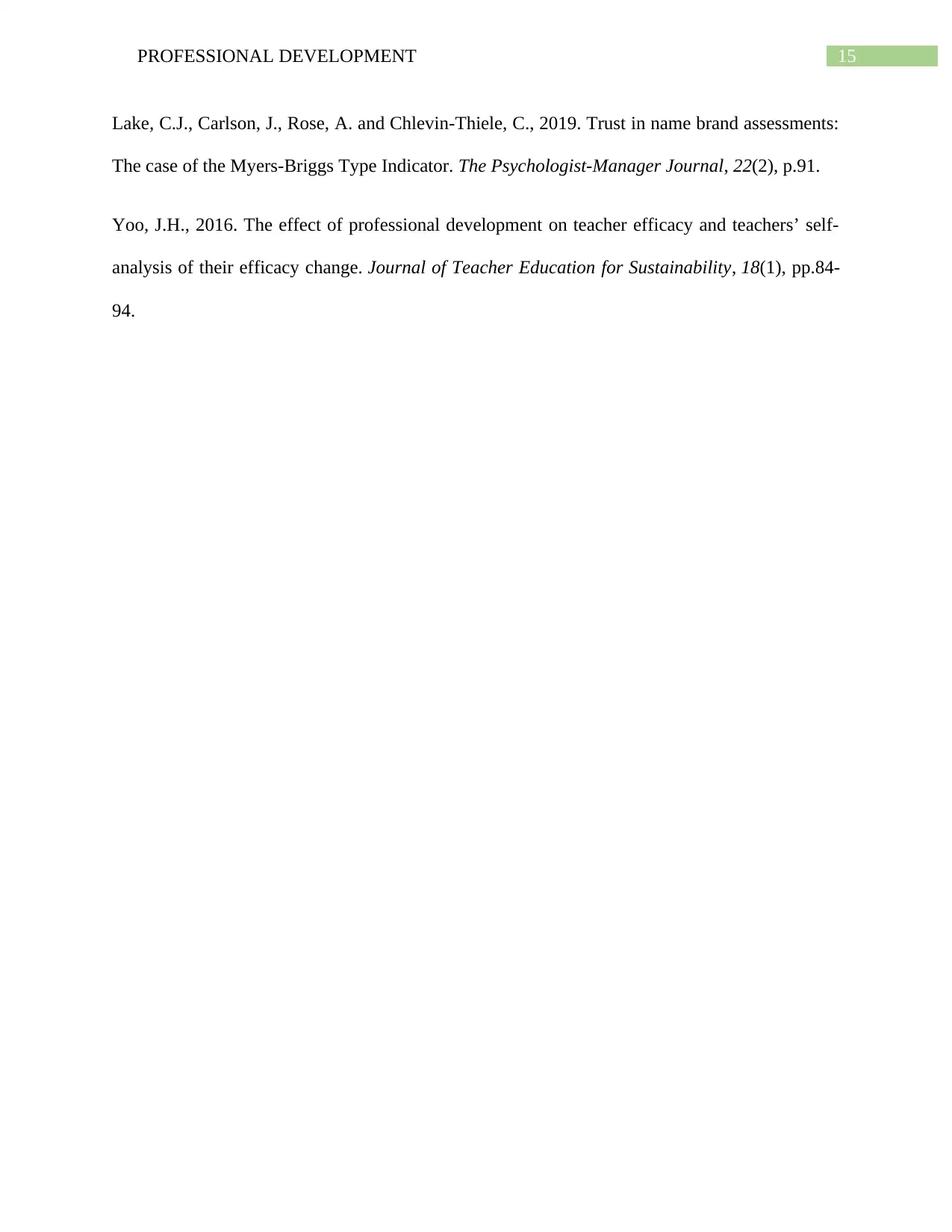
15PROFESSIONAL DEVELOPMENT
Lake, C.J., Carlson, J., Rose, A. and Chlevin-Thiele, C., 2019. Trust in name brand assessments:
The case of the Myers-Briggs Type Indicator. The Psychologist-Manager Journal, 22(2), p.91.
Yoo, J.H., 2016. The effect of professional development on teacher efficacy and teachers’ self-
analysis of their efficacy change. Journal of Teacher Education for Sustainability, 18(1), pp.84-
94.
Lake, C.J., Carlson, J., Rose, A. and Chlevin-Thiele, C., 2019. Trust in name brand assessments:
The case of the Myers-Briggs Type Indicator. The Psychologist-Manager Journal, 22(2), p.91.
Yoo, J.H., 2016. The effect of professional development on teacher efficacy and teachers’ self-
analysis of their efficacy change. Journal of Teacher Education for Sustainability, 18(1), pp.84-
94.
Secure Best Marks with AI Grader
Need help grading? Try our AI Grader for instant feedback on your assignments.
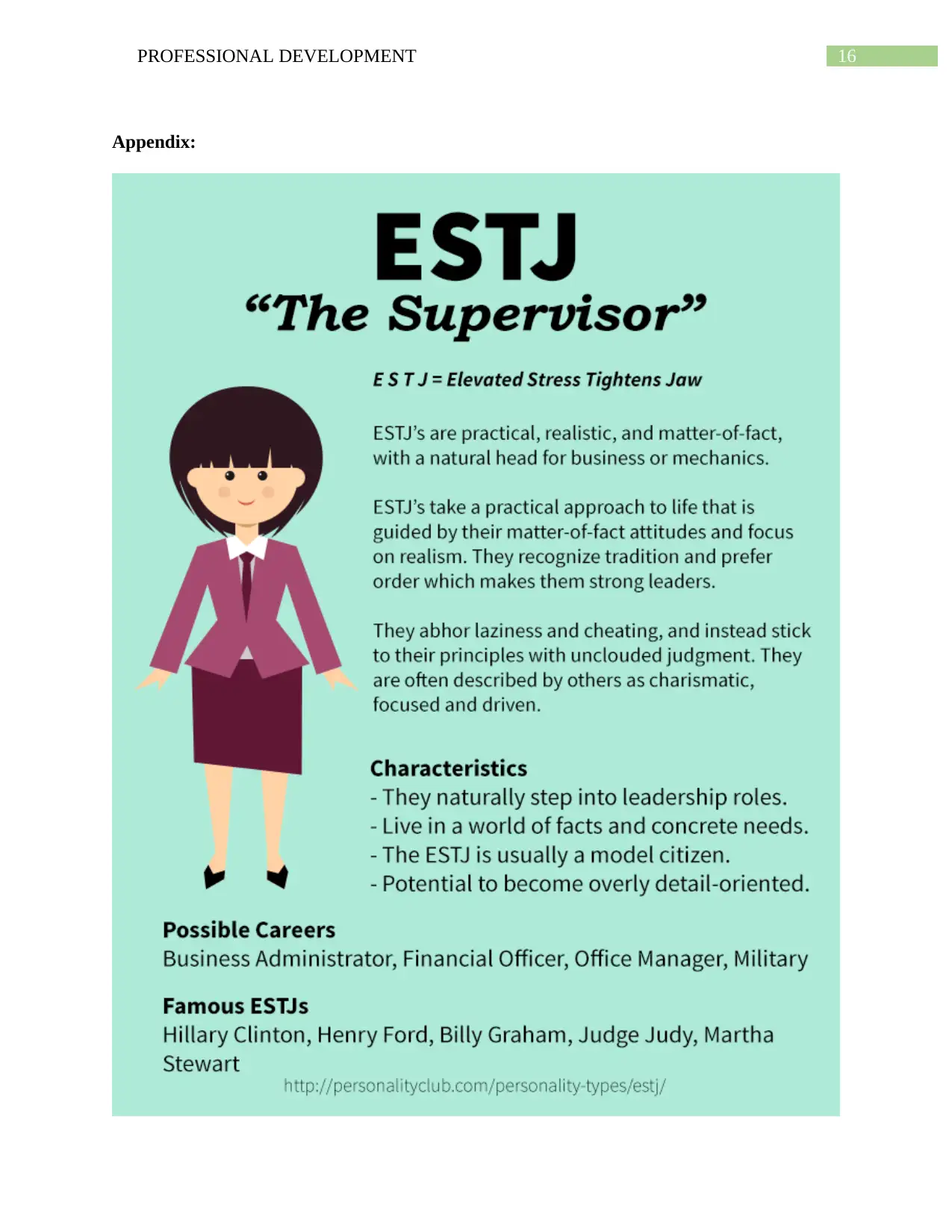
16PROFESSIONAL DEVELOPMENT
Appendix:
Appendix:
1 out of 17
Related Documents
Your All-in-One AI-Powered Toolkit for Academic Success.
+13062052269
info@desklib.com
Available 24*7 on WhatsApp / Email
![[object Object]](/_next/static/media/star-bottom.7253800d.svg)
Unlock your academic potential
© 2024 | Zucol Services PVT LTD | All rights reserved.





